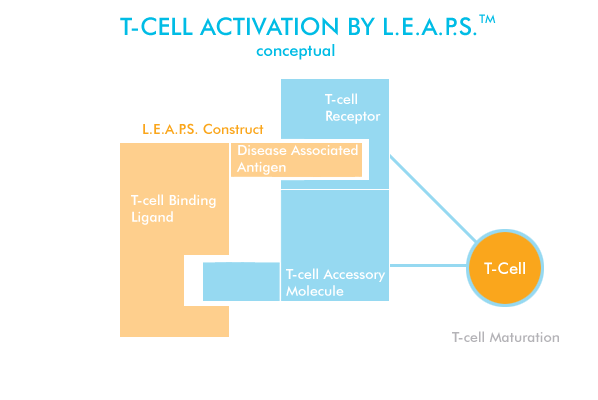|
Introduction and overview
L.E.A.P.S.™ is a patented, T-cell modulation, peptide epitope delivery technology that enables CEL-SCI to design and synthesize proprietary peptide immunogens. L.E.A.P.S.™ compounds consist of a small T-cell binding peptide ligand linked with a disease-associated peptide antigen.
This new technology has been shown in several animal models to preferentially direct immune response to a cellular (e.g. T-cell), humoral (antibody) or mixed pathway. Any disease for which antigenic epitope sequences have been identified, such as: infectious diseases, cancer, autoimmune diseases, allergic asthma and allergy, and select CNS diseases (e.g., Alzheimer’s) are potential candidates for this technology platform. The leading product candidate that has been developed from this technology is the CEL-1000 peptide.
This peptide has been shown to protect animals against malaria, herpes and cancer. This data was recently presented at a scientific meeting by U.S. Navy researchers. Most of the L.E.A.P.S.™ research and development program is supported by grants.
L.E.A.P.S.™ Overview
L.E.A.P.S.™ is a novel T-cell modulation platform technology that enables CEL-SCI to design and synthesize proprietary immunogens. Any disease for which an antigenic sequence has been identified such as: infectious, parasitic, malignant or autoimmune diseases and allergies are potential therapeutic or preventive sites for the application of L.E.A.P.S.™ technology.
The L.E.A.P.S.™ compounds are bi- or hetero- functional peptides, including an antigenic peptide (Ag) linked to another peptide referred to as a T-cell binding ligand (TCBL). This complex may allow the presentation of antigen to occur at the same time as delivery of a co-stimulatory signal. Several types of TCBL have been evaluated. Two of particular interest are used and are designated TCBL peptides J and G or the improved version, derG. Conjugates of these appear to activate different sub-sets of T-cells. J is a short fragment from b-microglobulin (aa38-50) and G or the improved form derG are a modified fragment from MHC II b-chain (aa135-149). Based on site directed mutagenesis studies of MHC II b-chain and/or peptide competition studies, G presumably binds to CD4, a T cell co-stimulator molecule.
The concept behind the L.E.A.P.S.™ technology is to directly mimic cell/cell interactions on the T-cell surface with synthetic peptides. The L.E.A.P.S™ constructs containing the antigenic disease epitope linked to a T-cell binding ligand (TCBL) can be manufactured by peptide synthesis or by covalently linking the two peptides. Depending upon the type of L.E.A.P.S.™ construct and TCBL used, CEL-SCI is able to direct the immune response outcome towards the development of T-cell function with primarily effector T-cell functions (T Lymphocyte; helper/effector T lymphocyte, type 1 or 2 [Th1 or Th2], cytotoxic [Tc] or suppressor [Ts]). Therefore, it would appear that L.E.A.P.S.™ construct represents a chimeric peptide with bi-functional behavior (as depicted in Figure 1).
| |
 |
| |
Schematic representation of a L.E.A.P.S.™
construct and a receptor on the T cell |
|

